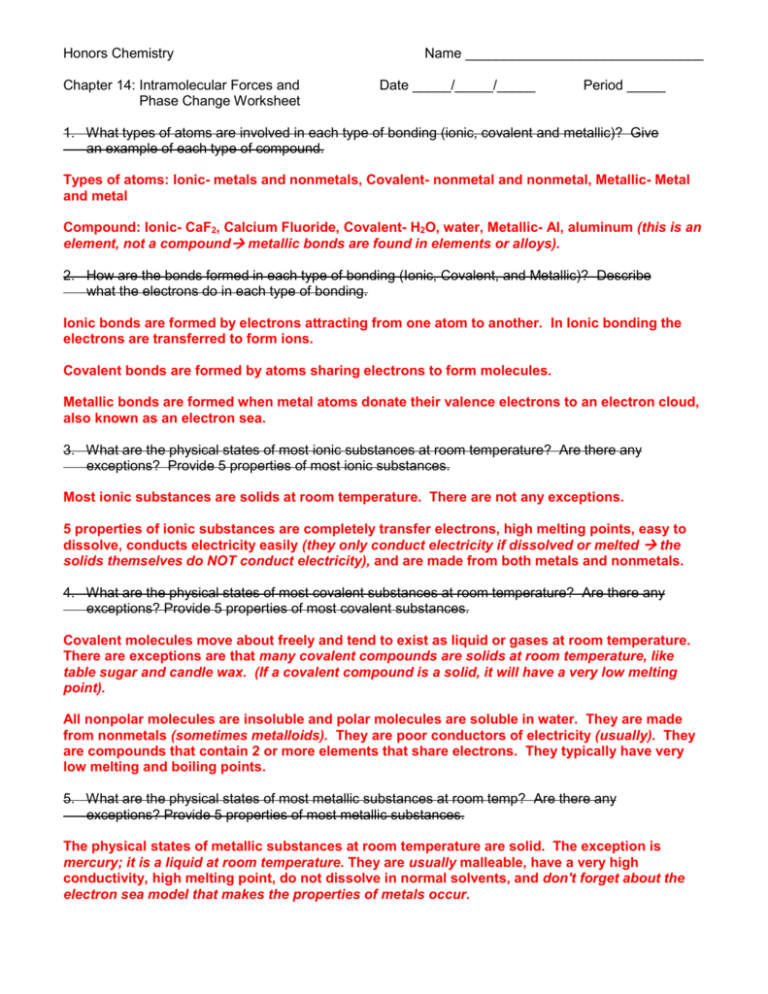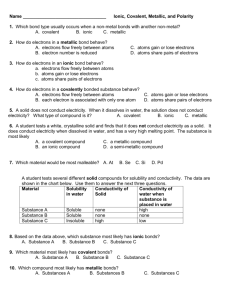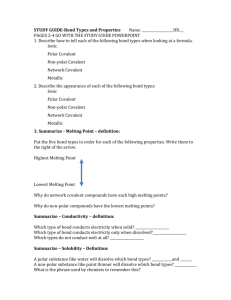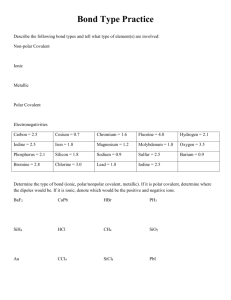THERE WILL NOT BE A WORD WALL, SO STUDY
advertisement

Honors Chemistry Chapter 14: Intramolecular Forces and Phase Change Worksheet Name _______________________________ Date _____/_____/_____ Period _____ 1. What types of atoms are involved in each type of bonding (ionic, covalent and metallic)? Give an example of each type of compound. Types of atoms: Ionic- metals and nonmetals, Covalent- nonmetal and nonmetal, Metallic- Metal and metal Compound: Ionic- CaF2, Calcium Fluoride, Covalent- H2O, water, Metallic- Al, aluminum (this is an element, not a compound metallic bonds are found in elements or alloys). 2. How are the bonds formed in each type of bonding (Ionic, Covalent, and Metallic)? Describe what the electrons do in each type of bonding. Ionic bonds are formed by electrons attracting from one atom to another. In Ionic bonding the electrons are transferred to form ions. Covalent bonds are formed by atoms sharing electrons to form molecules. Metallic bonds are formed when metal atoms donate their valence electrons to an electron cloud, also known as an electron sea. 3. What are the physical states of most ionic substances at room temperature? Are there any exceptions? Provide 5 properties of most ionic substances. Most ionic substances are solids at room temperature. There are not any exceptions. 5 properties of ionic substances are completely transfer electrons, high melting points, easy to dissolve, conducts electricity easily (they only conduct electricity if dissolved or melted the solids themselves do NOT conduct electricity), and are made from both metals and nonmetals. 4. What are the physical states of most covalent substances at room temperature? Are there any exceptions? Provide 5 properties of most covalent substances. Covalent molecules move about freely and tend to exist as liquid or gases at room temperature. There are exceptions are that many covalent compounds are solids at room temperature, like table sugar and candle wax. (If a covalent compound is a solid, it will have a very low melting point). All nonpolar molecules are insoluble and polar molecules are soluble in water. They are made from nonmetals (sometimes metalloids). They are poor conductors of electricity (usually). They are compounds that contain 2 or more elements that share electrons. They typically have very low melting and boiling points. 5. What are the physical states of most metallic substances at room temp? Are there any exceptions? Provide 5 properties of most metallic substances. The physical states of metallic substances at room temperature are solid. The exception is mercury; it is a liquid at room temperature. They are usually malleable, have a very high conductivity, high melting point, do not dissolve in normal solvents, and don't forget about the electron sea model that makes the properties of metals occur. 2 6. What does it mean for a covalent compound to be polar? A covalent compound is polar when the molecule has a dipole. For Example: The compounds of the elements Fluorine, Nitrogen and Oxygen all have dipoles when bonded with hydrogen. A polar bond has an uneven distribution of charge due to the difference of electronegativity of the elements involved in the chemical bond. A polar molecule dissolves in water because the water is also polar and “like dissolves like”. Non-polar molecules do not dissolve in water because once again “like dissolves like” and they are not alike. 7. What does it mean for a covalent compound to be non-polar? How could one test for the polarity of a compound? It is a covalent bond in which the bonding electrons are shared equally by the bonded atoms, resulting in a balanced distribution of electrical charge. One could test the difference in solubility. Those which dissolved (in water) are polar and those that dissolved in a non-polar solvent like carbon tetrachloride are non-polar because it is also non-polar. 8. What does the term “like dissolves like” mean? Provide examples as part of your answer. The term “like dissolves like” means that polar compounds dissolve in polar solvents and nonpolar compounds dissolve in non-polar solvents. Ethanol dissolving in water is an example of a polar compound dissolving in a polar solvent. Iodine dissolving in carbon tetrachloride is an example of a non-polar compound dissolving in a non-polar solvent. 9. What is an alloy? An alloy is a homogenous mixture of a solid solution that contains two or more metals. The atoms of one metal replace or occupy a position between the atoms of the other metal. 10. What type of alloy is steel? Where do the carbon atoms reside in steel? Steel is an interstitial alloy. The carbon atoms occupy positions between the atoms of iron. 11. What is a substitutional alloy? List three examples. Similar sized metal atoms replace the metal atoms of the major component metal. Ex: 8 carat gold is composed of 47% copper, 33% gold, and 20 % silver. Medal bronze is composed of 92 – 97 % copper, 1 – 8% tin, and 0 – 2% zinc. Pewter is composed of 60 – 61 % copper, 31 – 37 % zinc, 1.4 % tin, and 0.7 – 0.9 lead. 12. Describe the electron sea model of metallic bonds. The are metal cations have valence electrons that are loosely held and can therefore move from one metal atom to the next easily. The valence electrons are constantly moving around the cation and are shared by neighboring cations. The electrons move in a sea like motion that has 3 the effect of holding the positive charges in fixed positions. 13. In which type of bond are electrons shared between two atoms? a. ionic b. covalent c. metallic 14. Which type of bond creates a crystalline structure? a. ionic b. covalent c. metallic 15. Which type of bond usually forms between two nonmetals? a. ionic b. covalent c. metallic 16. Which type of bond is often described as an "electron sea"? a. ionic b. covalent c. metallic 17. Which type of bond is characterized by the formation of oppositely charged particles? a. ionic b. covalent c. metallic 18. Which of the following is NOT a characteristic of ionic substances? a. Are usually gases at room temperature. c. Have high melting points. b. Conduct electricity in solution form. d. Usually dissolve in water. 19. Which of the following is NOT a characteristic of metallic substances? a. Malleable and ductile. c. Have low melting points. b. Conduct electricity. d. Are usually solids at room temperature. 20. Which of the following is NOT a characteristic of covalent substances? a. Have low melting points. c. Form individual molecules. b. Sometimes dissolve in water. d. Conduct electricity. 21. Why do atoms form chemical bonds? a. To increase their potential energy. b. To become more stable. c. To gain more valence electrons. d. To obtain a higher electronegativity. 22. Select the statement that correctly describes a polar covalent bond. a. Electrons are shared equally between the atoms. b. One atom has a greater attraction for electrons (electronegativity) than the other. c. Partial positive and negative charges are produced. d. Both a and b. e. Both b and c. 4 Heating Curves 23. Draw a Heating Curve Diagram and label where each of the following would either be located on the curve or label on what part of the curve it would be used to complete calculations. a. Solid e. Liquid i. Vapor b. Specific Heat of Solid f. Specific Heat of Liquid j. Specific Heat of Vapor c. Melting/Freezing g. Vaporizing/Condensing d. Heat of Fusion h. Heat of Vaporization 24. What can be stated about the temperature change during any phase change? Energy is absorbed during a phase change but the temperature does not change. During the phase change, all of the energy is used to separate or partially separate the molecule from one another. This separation is simply the overcoming of the intermolecular forces of attraction. 25. What formula is used to calculate the change of energy in which the temperature changes within a phase? Q = mCpT (heat/energy = mass x specific heat x change in temperature) 26. What formula is used to calculate the amount of energy needed to change the phase of a substance? Q = H x moles (heat/energy = enthalpy of ______ x mole of substance) 5 27. CCl2F2 has a boiling point of -30. C, and a heat of vaporization of 0.165 kJ/g. The vapor and the liquid have specific heats of 0.61 J/gK and 0.97 J/gK respectively. How much heat must be evolved when 10.0 g of CCl2F2 is cooled from +40. C to -40. C? Q = mCpT = (10.0 g)( 0.61 J/gK)(–70 K) = –430 J Q = H x mass = (0.165 kJ/g)(10.0 g) = –1.65 kJ = –1650 J Q = mCpT = (10.0g)(0.97 J/gK)(–10 K) = –97 J – 2180 J 6 28. Calculate the quantity of energy required to heat 21.00 g of water from –7.00 oC to 102.0 oC. Cp(g) = 2.10 J / g oC H Fusion = 6.02 kJ /mole Cp(l) = 4.20 J / g oC H Vaporization = 40.7 kJ/mole Cp(s) = 2.10 J / g oC 21.00 g H2O │ 1mole H2O │ 18.02 g H2O ││ ││ 1.165 moles H2O Q = mCpT =(21.00 g)( 2.10 J / g oC)(7.00 oC) = 309 J Q = H x moles = (6.02 kJ/mole)(1.165 moles H2O) = 7.01 kJ = 7,010 J Q = mCpT = (21.00 g)(4.20 J / g oC)(100. oC) = 8820 J Q = H x moles = (40.7 kJ/mole)(1.165 moles H2O) = 47.4 kJ = 47,400 J Q = mCpT = (21.00 g)(2.10 J / g oC)(2.0 oC) = 88 J 63627 J = 63,600 J = 63.6 kJ Liquid-Vapor Equilibrium 29. When the rate of vaporization is equal to the rate of condensation in a closed container the liquid and vapor are in a state of equilibrium. 30. This means pressure exerted by the vapor over the liquid remains constant. 31. Vapor Pressure is the pressure exerted on the inside of the container by the vaporized gas. 32. What is the normal boiling point of a substance? It is the temperature at which the liquid changes to the gaseous state at a pressure of 1.00 atm. Phase Diagrams 33. A phase diagram is a graph that shows the temperature and pressure at which different phases are in equilibrium with each other. 34. Triple Point – is the only point where the solid, liquid, and gas phases can all coexist. 7 35. Sublimation – the process by which a solid phase changes directly into a gas phase without passing through the liquid phase. 36. Melting Point is identical to the freezing point. 37. An increase in pressure favors the formation of the solid and liquid phases. 38. In a phase diagram the line between the solid and liquid phases leans toward the least dense phase. 39. Label the following on the graphs below: a. All 3 states – solid, liquid, and gas b. The x-axis and y-axis c. Critical point d. Triple point e. Melting point f. Boiling Point g. Where normal pressure occurs. h. Across which line and which direction melting and freezing occurs. i. Across which line and which direction vaporization and condensation occurs. j. Across which line and which direction sublimation and deposition occurs. 40. Which of the above graph is the graph for water? Explain. The left graph is the phase diagram for water because it is the only substance known that the solid phase is less dense than the liquid phase. Because of the difference in density, the solid/liquid line leans to the left while all other substances the solid/liquid line will lean to the right.








